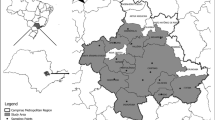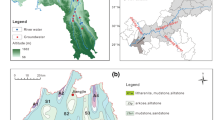Abstract
Significant levels of potentially carcinogenic bromate were measured in chlorinated tap drinking water in Metropolitan Manila, Philippines, using an optimized ion-chromatographic method. This method can quantify bromate in water down to 4.5 μg l−1 by employing a postcolumn reaction with acidic fuchsin and subsequent spectrophotometric detection. The concentration of bromate in tap drinking water samples collected from 21 locations in cities and municipalities within the 9-month study period ranged from 7 to 138 μg l−1. The average bromate concentration of all tap drinking water samples was 66 μg l−1 (n = 567), almost seven times greater than the current regulatory limit in the country. The levels of bromate in other water types were also determined to identify the sources of bromate found in the distribution lines and to further uncover contaminated sites. The concentration of bromate in water sourced from two rivers and two water treatment plants ranged from 15 to 80 and 12 to 101 μg l−1, respectively. Rainwater did not contribute bromate in rivers but decreased bromate level by dilution. Groundwater and wastewater samples showed bromate concentrations as high as 246 and 342 μg l−1, respectively. Bromate presence in tap drinking water can be linked to pollution in natural water bodies and the practice of using hypochlorite chemicals in addition to gaseous chlorine for water disinfection. This study established the levels, occurrence, and possible sources of bromate in local drinking water supplies.





Similar content being viewed by others
References
Asami M, Kosaka K, Kunikane S (2009) Bromate, chlorate, chlorite and perchlorate in sodium hypochlorite solution used in water supply. J Water Supply Res Technol AQUA 58:107–115
Becker WC, Schindler S, Freud S, Glaser C, Herzner J, Hoek K et al (2008) NYC: optimizing for DBP control. In: New York Section AWWA, spring meeting, Saratoga Springs, NY, USA. http://www.nysawwa.org/awpdf/aw922m.pdf. Accessed 4 December 2010
Bolyard M, Fair PS (1992) Occurrence of chlorate in hypochlorite solutions used for drinking water disinfection. Environ Sci Technol 26:1663–1665
Bouland S, Duguet JP, Montiel A (2005) Evaluation of bromate ions level introduced by sodium hypochlorite during postdisinfection of drinking water. Environ Technol 25:121–125
Bryant EA, Fulton GP, Budd GC (1992) Disinfection alternatives for safe drinking water. Van Nostrand Reinhold, New York, pp 19–20
Butler R, Godley A, Lytton L, Cartmell E (2005a) Bromate environmental contamination: review of impact and possible treatment. Crit Rev Environ Sci Technol 35:193–217
Butler R, Lytton L, Godley AR, Tothill IE, Cartmell E (2005b) Bromate analysis in groundwater and wastewater samples. J Environ Monit 7:999–1006
De Angelo AB, Georges MH, Kilburn SR, Moore TM, Wolf DC (1998) Carcinogenicity of potassium bromate administered in the drinking water to male B6C3F1 mice and F344/N rats. Toxicol Pathol 26:587–594
Dumol M (2000) The Manila water concession: a key government official’s diary of the world’s largest water privatization. The World Bank, Washington DC, p 137
Eaton AD, Clesceri LS, Rice EW, Greenberg AE (eds) (2005) Standard methods for the examination of water and wastewater, 21st edn (Centennial edition). American Public Health Association, American Water Works Association, and Water Environment Federation, Washington DC, pp 4-56–4-58
Elwaer A-H, Quevanviller P, Thompson KC, McLeod CW (2006) Bromate determination. In: Quevanviller P, Thompson KC (eds) Analytical methods for drinking water: advances in sampling and analysis. Wiley, Chichester, pp 39–62
Espino MP, Cimatu K (2003) Bromate levels in Metro Manila drinking water. Kimika 19:35–39
European Commission (2009) Revision of the drinking water directive. http://ec.europa.eu/environment/water/water-drink/revision_en.html. Accessed 10 July 2010
Garcia-Villanova RJ, Leite MVOD, Hierro JMH, SdC Alfageme, Hernandez CG (2010) Occurrence of bromate, chlorite and chlorate in drinking waters disinfected with hypochlorite reagents. Tracing their origins. Sci Total Environ 408:2616–2620
Genuino HC, Espino MPB (2009) Ion chromatographic method with post-column fuchsin reaction for measurement of bromate in chlorinated water. Sci Diliman 21:29–36
Hutchinson TH, Hutchings MJ, Moore KW (1997) A review of the effects of bromate on aquatic organisms and toxicity of bromate to oyster (Crassostrea gigas) embryos. Ecotoxicol Environ Saf 38:238–243
International Agency for Research on Cancer, World Health Organization (1991) Chlorinated drinking water; chlorination by-products; some other halogenated compounds; cobalt and cobalt compounds. IARC monographs on the evaluation of carcinogenic risks to humans, vol 52, Lyon, France, pp 72–107
Kemsley J (2007) Bromate in Los Angeles water. Chem Eng News 85:9
Legube B (1996) A survey of bromate ion in European drinking water. Ozone Sci Eng 18:325–348
Liongson LQ, Villa RC (2003) Flow measurement and water balance study of the Metro Manila water supply headworks system. In: Fourth regional symposium on infrastructure development in civil engineering (RSID4), Bangkok, Thailand, 3–5 April 2003
Macalady DL, Carpenter JH, Moore CA (1977) Sunlight-induced bromate formation in chlorinated seawater. Science 195:1335–1337
Maynilad Water Services, Incorporated (2009) Consumer education. How Maynilad makes water potable. Quezon City, Philippines. http://www.mayniladwater.com.ph/contact.php. Accessed 23 April 2011
National Statistics Office, Republic of the Philippines (2008) Total population and annual population growth rates by region: population censuses 1995, 2000, and 2007. Quezon City, Philippines. http://www.census.gov.ph/data/census2007/index.html. Accessed 23 April 2010
Packham RF (1999) Disinfection and disinfection by-products in Europe. In: Singer PC (ed) Formation and control of disinfection by-products in drinking water. American Water Works Association, Denver, pp 393–403
Philippine Daily Inquirer (2007, April 26) Talk of the Town, Sunday issue. Makati City, Philippines, p A19
Philippine National Standard for Drinking Water, Republic of the Philippines (2007) Standard values for chemicals used in treatment and disinfection and disinfection-by products, Section 2.13. Department of Health, Manila, Philippines, p 26. http://www.doh.gov.ph. Accessed 6 June 2009
Sage R (2010) Contamination of public drinking water boreholes by bromate. UK Groundwater Forum, Oxfordshire, UK. http://www.groundwateruk.org/Groundwater-projects-bromate-pollution.aspx. Accessed 22 May 2011
The Chlorine Institute (1999) Bromate in sodium hypochlorite solutions. A progress report. Chlorine Institute, Washington, DC. http://www.chlorineinstitute.org/files/FileDownloads/BromateinNaOCl-PotableWaterTreatment.pdf. Accessed 28 June 2008
United States Environmental Protection Agency (2011) List of drinking water contaminants and MCLs. USEPA, Washington, DC. http://water.epa.gov/drink/contaminants/index.cfm#Byproducts. Accessed 24 August 2011
Weinberg HS, Delconym CA, Unnam V (2003) Bromate in chlorinated drinking waters: occurrence and implications for future regulations. Environ Sci Technol 37:3104–3110
White GC (2010) On-site sodium hypochlorite generation system. In: White’s handbook of chlorination and alternative disinfections, 5th edn. Wiley, Hoboken, pp 528–571
World Health Organization (2008) Guidelines for drinking-water quality. Second addendum to third edition. http://www.who.int/water_sanitation_health/dwq/chemicals/bromate/en/. Accessed 22 May 2011
Xin H, Naiyun G, Yang D (2008) Bromate ion formation in dark chlorination and ultraviolet/chlorination processes for bromide-containing water. J Environ Sci 20:246–251
Acknowledgments
The authors thank the Research and Development Division of the Environmental Management Bureau (Philippines) for the use of their laboratory facilities. H. C. Genuino gratefully acknowledges the Commission on Higher Education for the financial support of his master’s thesis. The cooperation of the MWSS and its two concessionaires, namely, MWSI and MWCI, is likewise appreciated.
Author information
Authors and Affiliations
Corresponding author
Electronic supplementary material
Below is the link to the electronic supplementary material.
Rights and permissions
About this article
Cite this article
Genuino, H.C., Espino, M.P.B. Occurrence and Sources of Bromate in Chlorinated Tap Drinking Water in Metropolitan Manila, Philippines. Arch Environ Contam Toxicol 62, 369–379 (2012). https://doi.org/10.1007/s00244-011-9707-6
Received:
Accepted:
Published:
Issue Date:
DOI: https://doi.org/10.1007/s00244-011-9707-6




